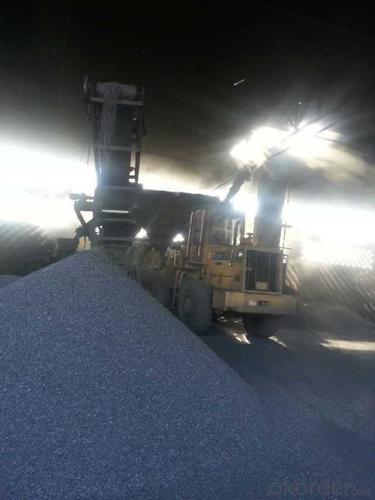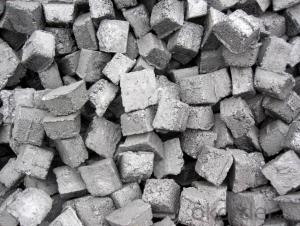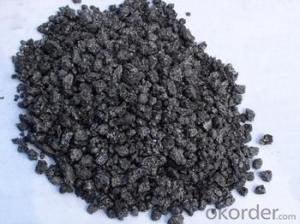FC 93% Calcined Anthracite
- Loading Port:
- China Main Port
- Payment Terms:
- TT or LC
- Min Order Qty:
- 20 m.t.
- Supply Capability:
- 1000 m.t./month
OKorder Service Pledge
OKorder Financial Service
You Might Also Like
FC 93% Calcined Anthracite
It used the high quality anthracite as raw materials through high temperature calcined at over 2000 by the DC electric calciner with results in eliminating the moisture and volatile matter from anthracite efficiently, improving the density and the electric conductivity and strengthening the mechanical strength and anti-oxidation.
It has good characteristics with low ash, low resistvity, low sulphur, high carbon and high density. It is the best material for high quality carbon products.
Product Uses
Calcined Anthracite Coal may substitute massively refinery coke or graphite. Meanwhile its cost is much less than the refinery coke and graphite. Carbon Additive is mainly used in electric steel ovens, water filtering, rust removal in shipbuilding and production of carbon material.
Calcined Anthracite
Fixed carbon: 90%-95%
S: 0.5% max
Size: 0-3. 3-5.3-15 or as request
General Specification of Calcined Anthracite:
PARAMETER UNIT GUARANTEE VALUE | |||||
F.C.% | 95MIN | 94MIN | 93MIN | 92MIN | 90MIN |
ASH % | 4MAX | 5MAX | 6MAX | 7MAX | 8MAX |
V.M.% | 1 MAX | 1MAX | 1.5MAX | 1.5MAX | 1.5MAX |
SULFUR % | 0.5MAX | 0.5MAX | 0.5MAX | 0.5MAX | 0.5MAX |
MOISTURE % | 0.5MAX | 0.5MAX | 0.5MAX | 0.5MAX | 0.5MAX |
Size can be adjusted based on buyer's request.
Pictures of Calcined Anthracite:

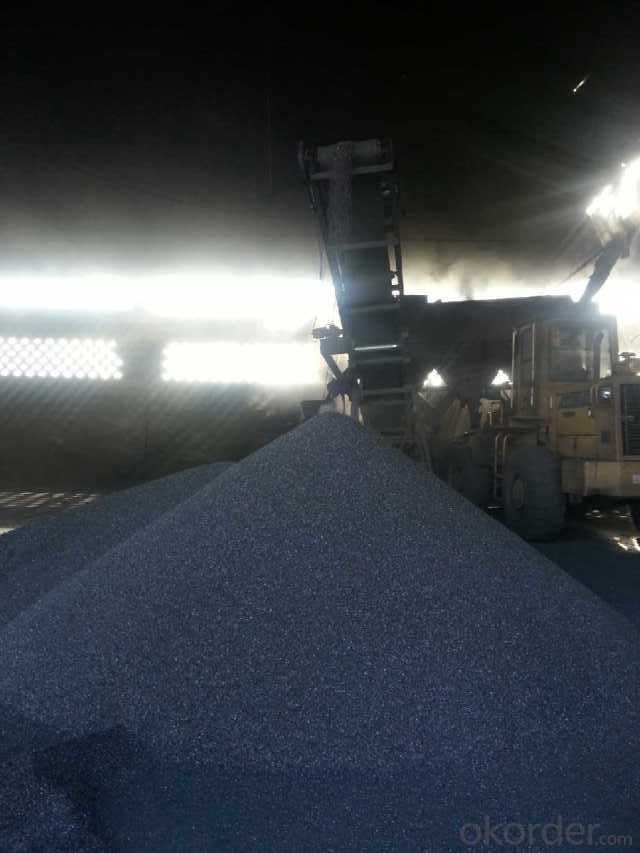
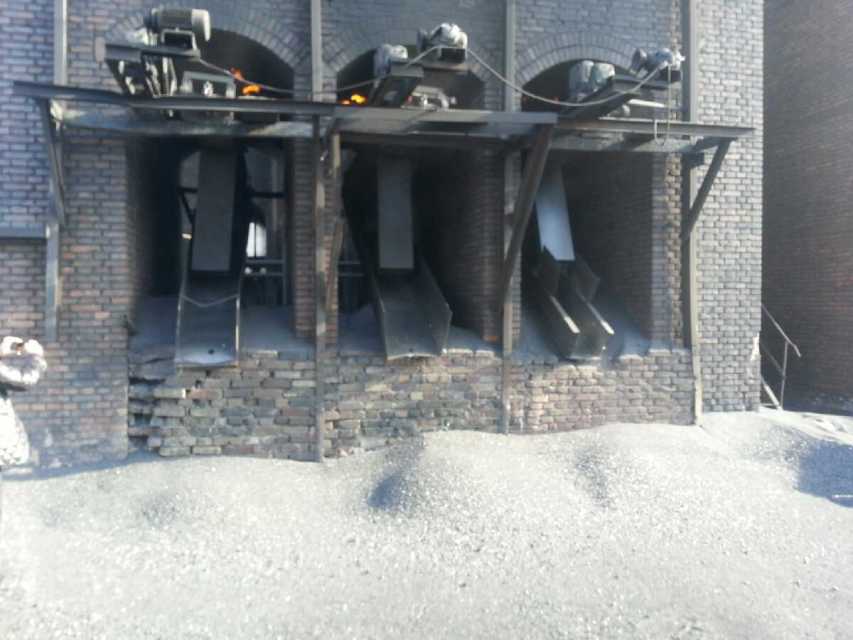
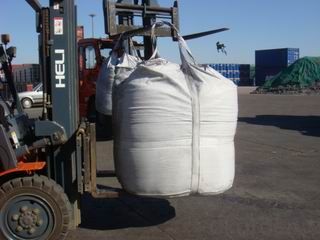
We can supply below furnace charges, please feel free to contact us if you areinterested in any of any of them:Coke (Metallurgical, foundry, gas)
Calcined Anthracite with fixed carbon from 90% to 95%
- Q: Method for making carbon fiber board
- Method for making carbon fiber sheet:1, first determine the thickness of the plate to be made2 calculate the required number of plies according to the thickness3, and then according to 0 degrees, 45 degrees, 90 degrees, -45 degrees in the order of stacking.4, and then molding it!Now carbon fiber board, in fact, many in the middle are entrained with some glass fiber cloth, of course, there are all carbon, a little more expensive!
- Q: How is carbon used in the production of filters?
- Carbon is commonly used in the production of filters due to its unique properties. One of the main uses of carbon in filters is its ability to adsorb, or attract and hold onto, impurities and contaminants. This is because carbon has a large surface area with many tiny pores, allowing it to effectively trap and remove particles, chemicals, and odors from air, water, and other substances. In air filters, carbon is often combined with other materials, such as activated charcoal, to create activated carbon filters. These filters are used to remove pollutants, allergens, and odors from the air. The activated carbon adsorbs the contaminants, trapping them within its porous structure and improving the overall air quality. In water filters, carbon can be used in different forms, such as granular activated carbon (GAC) or carbon block filters. GAC filters are commonly used in household water filtration systems and are effective in removing chlorine, volatile organic compounds (VOCs), pesticides, and other chemicals. Carbon block filters, on the other hand, are made by compressing activated carbon into a solid block, providing a higher surface area and better filtration efficiency. In addition to air and water filters, carbon is also used in various other types of filters, such as those used in industrial processes, gas masks, and respirators. The versatility of carbon in filtering applications is due to its ability to adsorb a wide range of contaminants and its high adsorption capacity. Its use in filters helps improve the quality and safety of the substances being filtered, making it an essential material in many filtration processes.
- Q: How does carbon affect the formation of smog?
- Carbon plays a significant role in the formation of smog, particularly in the form of carbon monoxide (CO) and volatile organic compounds (VOCs). When fossil fuels are burned, such as in vehicles, power plants, or industrial processes, carbon is released into the atmosphere in the form of CO and VOCs. These carbon emissions, especially in areas with high population density, can contribute to the formation of smog. Smog is a mixture of air pollutants, primarily ground-level ozone, which is formed when nitrogen oxides (NOx) and VOCs react in the presence of sunlight. Carbon monoxide is a precursor to the formation of ground-level ozone. It reacts with nitrogen oxides and sunlight to form ozone, a major component of smog. VOCs, on the other hand, react with nitrogen oxides in the presence of sunlight to form additional ground-level ozone. Additionally, carbon particles, also known as black carbon or soot, can contribute to the formation of smog. These particles absorb sunlight and heat the surrounding air, leading to temperature inversions. Temperature inversions trap pollutants close to the ground, preventing them from dispersing and exacerbating smog formation. Reducing carbon emissions is crucial in controlling and preventing smog formation. Implementing cleaner technologies, such as catalytic converters in vehicles and using cleaner fuels, can help decrease the release of carbon monoxide and VOCs. Furthermore, promoting renewable energy sources and reducing reliance on fossil fuels can significantly reduce carbon emissions, thus mitigating the formation of smog.
- Q: What are the consequences of increased carbon emissions on human health?
- Increased carbon emissions have numerous consequences on human health. Firstly, carbon emissions contribute to the formation of air pollution, specifically fine particulate matter (PM2.5) and ground-level ozone, which can lead to respiratory issues such as asthma, bronchitis, and other respiratory diseases. Additionally, exposure to air pollution from carbon emissions has been linked to an increased risk of cardiovascular diseases, including heart attacks and strokes. Moreover, carbon emissions contribute to climate change, resulting in more frequent and intense heatwaves, extreme weather events, and the spread of infectious diseases. These phenomena can have direct and indirect impacts on human health, leading to heat-related illnesses, injuries, mental health issues, and the displacement of communities. Overall, the consequences of increased carbon emissions on human health are significant and require urgent action to mitigate their effects.
- Q: What is latent carbon?
- With prochiral carbon atoms called prochiral molecules.For potential chiral compounds, can also be used to determine the order of rule configuration. For example, an atom of hydrogen by deuterium methylene propionate (D) replaced, if converted into R configuration, the hydrogen atom is called latent -R (pro-R) hydrogen atoms into S; if the configuration is called latent -S (pro-S the hydrogen atom).For medical workers, prochiral is an important concept. Almost all of the biological chemical reaction is controlled by the enzyme, the enzyme for prochiral molecules not symmetrically reaction, so they are able to identify two identical atoms or atomic groups, because they are chiral compounds. For example two methylene citric acid and only one methylene by enzymes (from rat liver) into carbonyl group.
- Q: How does carbon affect the formation of desertification?
- The formation of desertification is not directly affected by carbon. Rather, desertification is primarily caused by a combination of natural factors, such as climate change, prolonged drought, and human activities like deforestation and overgrazing. However, carbon does play an indirect role in exacerbating desertification through climate change. Carbon dioxide (CO2), a greenhouse gas, is released into the atmosphere through human activities, particularly the burning of fossil fuels. The increased concentration of CO2 in the atmosphere leads to global warming, which alters climate patterns and increases the frequency and intensity of droughts. Prolonged droughts deplete soil moisture, making the land more susceptible to erosion and degradation, thus contributing to the desertification process. Furthermore, carbon indirectly affects desertification through deforestation. Trees and other vegetation play a vital role in maintaining healthy soil by preventing erosion, retaining moisture, and providing shade. When forests are cleared, the carbon stored in trees is released into the atmosphere, contributing to higher CO2 levels. Additionally, the loss of vegetation cover exposes the soil to erosion by wind and water, which accelerates desertification. It is important to acknowledge that while carbon indirectly impacts desertification through climate change and deforestation, desertification itself is a complex process influenced by various factors. Addressing desertification requires a comprehensive approach involving sustainable land management practices, reforestation efforts, water management, and strategies to mitigate climate change.
- Q: How does carbon impact the availability of freshwater resources?
- The availability of freshwater resources is impacted by carbon in several interconnected ways. Climate change is one of the primary means through which carbon affects freshwater availability. The burning of fossil fuels and other human activities result in increased levels of carbon dioxide in the atmosphere, which contributes to global warming. This warming, in turn, leads to changes in precipitation patterns, including alterations in rainfall distribution and intensity. The emission of carbon also leads to warmer temperatures, which can cause higher rates of evaporation and more frequent and severe droughts in specific regions. These droughts reduce the amount of water accessible for freshwater resources like rivers, lakes, and reservoirs. Furthermore, the shifting climate can disrupt natural water cycles, impacting the replenishment of groundwater aquifers, which are essential sources of freshwater. Moreover, the quality of freshwater resources is impacted by carbon. The increased carbon emissions reacting with atmospheric moisture result in acid rain, which acidifies freshwater bodies and renders them unsuitable for many aquatic organisms. This disruption to ecosystems can lead to the loss of species that depend on freshwater resources for their survival. Another manner in which carbon affects freshwater availability is through its influence on land use. The conversion of forests and wetlands into agricultural or urban areas releases carbon stored in vegetation and soil. This not only adds to carbon emissions but also diminishes the ability of natural ecosystems to retain and filter water. Forests, for instance, play a crucial role in maintaining the water cycle by absorbing rainfall and gradually releasing it into streams and groundwater. Deforestation disrupts this process and can result in reduced water availability downstream. In conclusion, carbon emissions have a profound impact on the availability of freshwater resources. Through climate change, carbon alters precipitation patterns, resulting in droughts and decreased water availability. It also affects the quality of freshwater through phenomena like acid rain. Moreover, land-use changes driven by carbon emissions can further diminish freshwater availability by disrupting natural water cycles.
- Q: How does carbon affect the formation of toxic algal blooms?
- Carbon can affect the formation of toxic algal blooms by providing an essential nutrient source for the growth and proliferation of algae. Increased carbon levels in water bodies, often caused by human activities such as excessive fertilizer use and wastewater discharge, can lead to an imbalance in the aquatic ecosystem. This imbalance promotes the rapid growth of algae, including toxic species, which can release harmful toxins into the water, posing risks to human and animal health as well as the overall ecological health of the water body.
- Q: What does carbon burning mean?
- Put the burning carbon under the iron plate and make a copy of it on the iron plate, that is, carbon burning!
Send your message to us
FC 93% Calcined Anthracite
- Loading Port:
- China Main Port
- Payment Terms:
- TT or LC
- Min Order Qty:
- 20 m.t.
- Supply Capability:
- 1000 m.t./month
OKorder Service Pledge
OKorder Financial Service
Similar products
Hot products
Hot Searches

